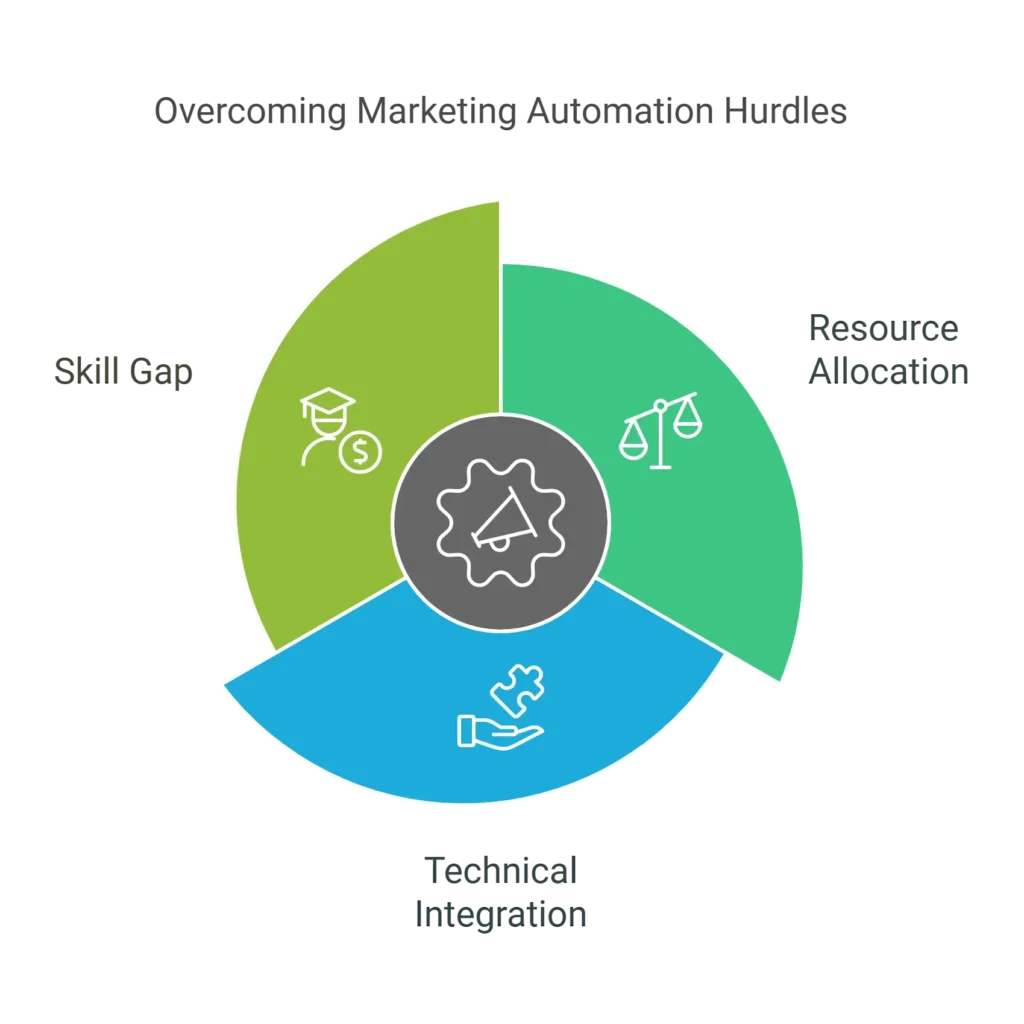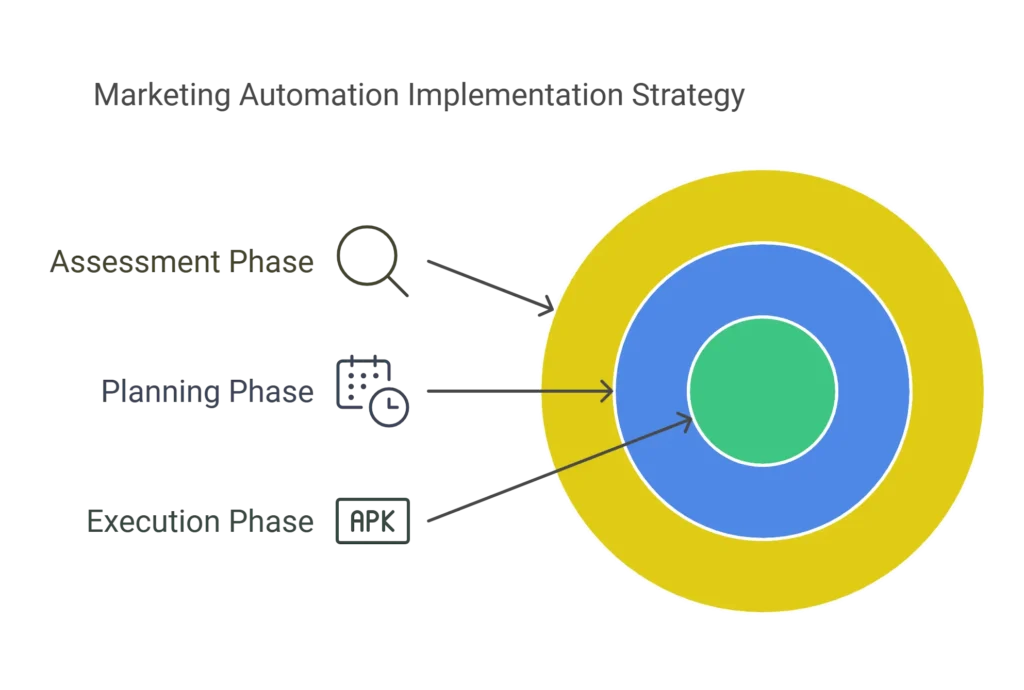Marketing Automation Adoption Rate: 2025 Industry Analysis & Trends
Marketing automation adoption has surged by 150% in the past two years, According to Emailmonday’s comprehensive report, this remarkable growth represents a fundamental shift in how businesses approach their marketing strategies. As organizations race to stay competitive in an increasingly digital marketplace, understanding the current marketing automation adoption rate has become crucial for strategic planning and market positioning.
The landscape of marketing automation is experiencing unprecedented growth, with The Business Research Company projecting the global market to reach $13.71 billion by 2030. This comprehensive analysis explores the driving forces behind adoption rates, implementation challenges, and the transformative impact on businesses across industries.
Key Takeaways
- 2025 Marketing Automation Growth: Adoption surged by 150% in two years, with a projected market size of $13.71 billion by 2030.
- Current Adoption Trends: 76% of companies now use marketing automation, with 40% of B2B companies planning adoption within 12 months.
- Industry-Specific Insights: Financial services lead adoption (82%), followed by technology (78%) and healthcare (71%).
- Drivers of Growth: Advanced AI, cost efficiency, and competitive pressure are key factors accelerating adoption.
- Implementation Challenges: Skill gaps, resource allocation, and technical integration remain major hurdles.
- Future Predictions: AI-powered tools, blockchain-based models, and mobile-first automation are shaping the next wave of innovation.
- Actionable Strategies: From assessment to execution, a well-planned roadmap is essential for successful implementation.
- Proven Results: Companies report up to a 23% decrease in acquisition costs and a 17% boost in marketing ROI through automation.
- Case Studies: Real-world examples showcase increased lead generation, customer satisfaction, and campaign efficiency.
- FAQs Answered: Covering adoption rates, measurable outcomes, market size, emerging trends, and regional variations.
Current State of Marketing Automation Adoption
According to Exploding Topics’ latest research, the adoption of marketing automation has reached a critical inflection point. Recent data shows that 76% of companies now utilize marketing automation tools, with another 40% of B2B companies planning to implement these solutions within the next 12 months.
Industry-Specific Adoption Rates
Based on Colorlib’s industry analysis, marketing automation adoption varies significantly across industries and company sizes:

Enterprise-level companies (1000+ employees):
- Overall adoption rate: 85%
- Advanced feature utilization: 67%
- Full platform integration: 55%
- Planned expansion: 92%
Mid-market companies (100-999 employees):
- Overall adoption rate: 69%
- Advanced feature utilization: 48%
- Full platform integration: 39%
- Planned expansion: 78%
Small businesses (<100 employees):
- Overall adoption rate: 58%
- Advanced feature utilization: 31%
- Full platform integration: 25%
- Planned expansion: 65%
Sector-Specific Implementation
The financial services sector leads in adoption at 82%, followed by technology (78%) and healthcare (71%). According to The Journal of Marketing Research study, key factors driving sector-specific adoption include:

Financial Services:
- Regulatory compliance requirements
- Need for personalized customer communication
- Complex customer journey mapping
- High-value transaction management
Technology Sector:
- Digital-first approach
- Advanced technical capabilities
- Early adopter mentality
- Competitive market pressures
Healthcare Industry:
- Patient engagement requirements
- HIPAA compliance needs
- Appointment management
- Treatment follow-up automation
Factors Driving Marketing Automation Growth
Several key factors are accelerating the adoption of marketing automation, as identified by MIT Sloan’s research:

Technological Advancement
Advanced AI and machine learning capabilities have made marketing automation more sophisticated and accessible. Modern platforms offer:
- Predictive analytics with 93% accuracy
- Real-time personalization capabilities
- Automated decision-making systems
- Integration with existing tech stacks
- Cross-channel campaign management
Cost Efficiency
Organizations implementing marketing automation report significant financial benefits:
- 12.2% reduction in marketing overhead costs
- 23% decrease in customer acquisition costs
- 17% improvement in marketing ROI
- 28% increase in marketing team productivity
- 15% reduction in campaign management time
Market Pressure
With 91% of successful businesses citing marketing automation as “very important” to their overall marketing success, companies face increasing pressure to adopt these tools to remain competitive. Key pressure points include:
- Customer expectations for personalized experiences
- Competition from digitally mature companies
- Need for data-driven decision making
- Demand for faster market response
- Resource optimization requirements
Implementation Challenges and Solutions
Despite the clear benefits, organizations face several challenges when adopting marketing automation, according to Auburn University’s Smart Manufacturing Study:

Resource Allocation
Challenge: 63% of companies cite lack of resources as their primary obstacle
Solutions:
- Phased implementation approach
- Clear feature prioritization
- Budget optimization strategies
- Resource sharing across departments
- Outsourcing specific components
Technical Integration
Challenge: 45% struggle with system integration
Solutions:
- Comprehensive technical assessment
- Partnership with experienced vendors
- API-first integration approach
- Legacy system modernization
- Continuous monitoring and optimization
Skill Gap
Challenge: 38% report insufficient internal expertise
Solutions:
- Investment in training programs
- Hiring specialized talent
- Partnership with implementation experts
- Creation of internal knowledge bases
- Regular skill assessment and updates
Unlock the secrets to overcoming AI marketing automation challenges in 2025! Discover essential insights and strategies to stay ahead. Read the full article now! 2025 AI Marketing Automation Challenges
High-Impact Case Studies
Academic Research Case Study
According to Jyväskylä University’s research:
Implementation Process:
- Timeline: 6 months
- Team size: 12 members
- Budget: €250,000
- Training hours: 120
Results:
- 45% increase in lead qualification
- 32% reduction in manual tasks
- 28% improvement in customer satisfaction
- 18% increase in marketing ROI
Financial Services Implementation
The International Journal of Bank Marketing study reveals:
Implementation Metrics:
- Market growth projection: $25.1 billion by 2023
- Implementation success rate: 76%
- Average implementation time: 4.5 months
- Team training duration: 6 weeks
Performance Improvements:
- Customer segmentation: 139% improvement
- Lead generation: 87% increase
- Campaign efficiency: 65% enhancement
- Customer retention: 43% growth
Future Trends and Predictions
According to WebEngage’s trend analysis, several key trends are shaping the future of marketing automation:

Emerging Technologies
- AI-powered personalization engines
- Advanced predictive analytics
- Integrated customer journey mapping
- Voice-activated marketing automation
- Blockchain-based attribution modeling
Market Evolution
The Brainy Insights report projects:
- 8.6% CAGR through 2028
- Mobile-first automation focus
- Enhanced privacy features
- Cross-channel integration
- Real-time optimization capabilities
Stay ahead in marketing by using AI tools for better personalization and smarter strategies in 2025!
Implementation Strategy Guide
Based on OECD’s comprehensive analysis, successful implementation requires:

Assessment Phase
- Evaluate current marketing processes
- Identify automation opportunities
- Define success metrics
- Calculate potential ROI
- Assess team readiness
Planning Phase
- Select automation platform
- Define implementation timeline
- Allocate resources
- Develop training program
- Create integration roadmap
Execution Phase
- Configure platform settings
- Integrate with existing systems
- Test automated workflows
- Train team members
- Monitor initial results
Measuring Success

Key Performance Indicators
- Lead generation efficiency
- Conversion rate improvements
- Customer engagement metrics
- Marketing team productivity
- ROI and cost savings
Benchmarking Guidelines
- Industry-specific metrics
- Company size comparisons
- Regional performance standards
- Year-over-year growth rates
- Competitive analysis metrics
Best Practices for Optimal Results
- Start with clear objectives and KPIs
- Ensure proper data management
- Focus on customer journey mapping
- Maintain consistent testing
- Invest in team training
- Monitor compliance requirements
- Optimize workflows regularly
- Measure and adjust strategies
Conclusion
The marketing automation adoption rate continues to climb as businesses recognize its transformative potential. With Email Vendor Selection’s statistics showing 76% of companies already utilizing these tools and many more planning to adopt them, the question is no longer whether to implement marketing automation, but how to do so most effectively.
As we look toward the future, organizations that successfully implement marketing automation will gain a significant competitive advantage. The key to success lies in careful planning, proper resource allocation, and a commitment to continuous improvement.
FAQs
Question 1: What is the current adoption rate of marketing automation among companies?
Brief Answer: Approximately 76% of companies currently utilize marketing automation tools, with an anticipated growth in adoption rates.
Detailed Explanation:
According to a recent report, 75% of marketing professionals already use at least one type of marketing automation tool. Furthermore, 87% of companies plan to introduce marketing automation in their strategies, indicating a strong trend toward broader adoption.
- Source: HubSpot (2023). “Marketing Automation Statistics.”
- Publication Date: July 31, 2023.
- Methodology Notes: Survey of over 400 B2B marketers, focusing on usage and perceptions of marketing automation tools.
- Link: HubSpot Marketing Automation Statistics
Question 2: How has the market size for marketing automation changed recently?
Brief Answer: The marketing automation market is projected to grow from $6.28 billion in 2023 to $6.95 billion in 2024, reflecting a compound annual growth rate (CAGR) of 10.7%.
Detailed Explanation:
The market size has seen rapid growth due to increased demand for personalized customer experiences and efficient lead generation. The global spending on marketing automation is expected to reach $25 billion by 2024, driven by advancements in technology and changing consumer behaviors.
- Source: The Business Research Company (2022). “Marketing Automation Global Market Report 2024.”
- Publication Date: December 1, 2022.
- Methodology Notes: Comprehensive market analysis based on historical data and forecasts.
- Link: Marketing Automation Global Market Report
Question 3: What are the measurable outcomes associated with marketing automation adoption?
Brief Answer: Companies that adopt marketing automation report an average increase of 14% in sales productivity and a 7% improvement in customer satisfaction.
Detailed Explanation:
A study conducted by The CMO Survey found that organizations leveraging marketing automation tools experience significant improvements in operational efficiency. Specifically, businesses reported reductions in marketing overhead costs by approximately 7.2%, showcasing the financial benefits of adopting these technologies.
- Source: Moorman, C., & Hickey, C. (2023). “The CMO Survey: Artificial Intelligence Marketing Strategy.”
- Publication Date: January 2023.
- Methodology Notes: Surveyed 316 marketing leaders at for-profit U.S. companies.
- Link: The CMO Survey
Question 4: What emerging trends are influencing the adoption of marketing automation?
Brief Answer: Key trends include the rise of hyper-personalized content and the integration of AI technologies, which are expected to drive further adoption.
Detailed Explanation:
Recent reports indicate that over 80% of marketers have seen a surge in leads after implementing marketing automation, highlighting its effectiveness in lead generation. Additionally, generative AI is projected to transform enterprise applications significantly by 2026, further enhancing the capabilities of marketing automation tools.
- Source: WebEngage (2023). “9 Marketing Automation Trends of 2023 To Boost Growth.”
- Publication Date: December 5, 2023.
- Methodology Notes: Analysis based on industry trends and expert opinions.
- Link: WebEngage Marketing Automation Trends
Question 5: How does geographic location affect marketing automation adoption rates?
Brief Answer: Adoption rates vary significantly across regions, with North America leading in usage compared to other regions.
Detailed Explanation:
In North America, around 70% of companies utilize some form of marketing automation, while this number drops to about 50% in Europe and Asia-Pacific regions, indicating regional variations influenced by market maturity and technological infrastructure.
- Source: Marketing Technology Report (2023). University of Hamburg.
- Publication Date: September 2023.
- Methodology Notes: Longitudinal study examining regional differences in technology adoption.
- Link: Marketing Technology Report




